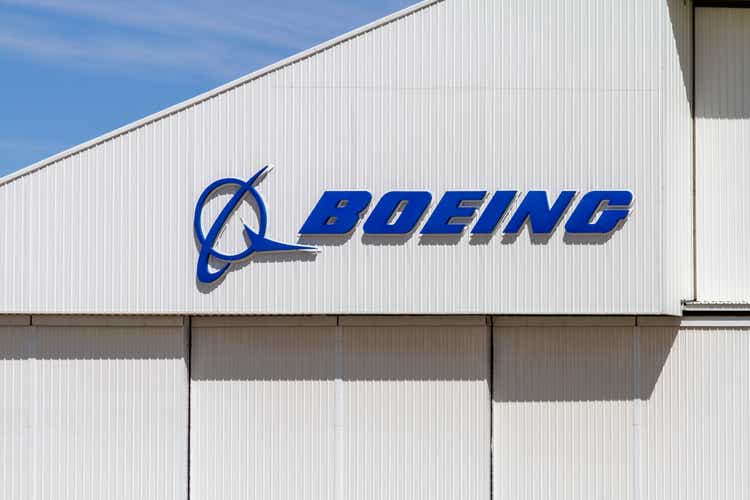Wall Street Lunch: Boeing Loss Narrows
Summary:
- Boeing’s Q1 loss narrows to $355 million, beating estimates.
- March durable goods orders rose 2.6% M/M.
- Stock investors face ‘meaningful losses’ from S&P 500’s slide but hope lies in a key metric – SentimenTrader.
sanfel
Listen below or on the go on Apple Podcasts and Spotify
Boeing topped estimates on the top and bottom lines. (0:16) AT&T reaffirms guidance. (1:46) Iron ore futures hit highest level in 7 weeks. (3:53)
This is an abridged transcript of the podcast.
Our top story so far
Boeing’s (NYSE:BA) results were better than feared as the plane maker continues to grapple with addressing safety issues.
The company’s loss narrowed to $355 million, or $0.56 a share, from $425 million, or $0.69 a share, a year earlier. Its loss adjusted for one-time items was $1.13 a share, better than the consensus estimate for an adjusted loss of $1.43 a share.
Revenue fell 7.3% from a year earlier to $16.6 billion, compared with the consensus estimate of $17.2 billion. Operating cash flow dropped to negative $3.36 billion from negative $318 million a year earlier amid fewer deliveries of commercial planes.
Last month, Boeing warned that its cash outlays would be between $4 billion and $4.5 billion in the quarter, greater than previously estimated. The company had $7.5 billion of cash and investments at the end of March, or less than half what it had at the beginning of the year.
Lawmakers and aviation authorities have intensified their scrutiny of Boeing after a new 737 Max 9 jet on January 5 lost a metal plug used in place of an emergency exit door shortly after takeoff. The FAA placed a 90-day limit on Boeing’s production of the 737 to push the company to improve its safety culture.
Outgoing CEO Dave Calhoun said: “Our first quarter results reflect the immediate actions we’ve taken to slow down 737 production to drive improvements in quality. We will take the time necessary to strengthen our quality and safety management systems, and this work will position us for a stronger and more stable future.”
In other earnings and active stocks
AT&T (T) beat first-quarter profit estimates, but revenue fell shy. CEO John Stankey reaffirmed the company’s full-year consolidated financial guidance.
AT&T added 349,000 postpaid phone subscribers in the first quarter, beating the 303,539 average estimate of analysts. The company added 252,000 new customers for its fiber service. The forecast was for 260,000.
Hasbro (HAS) rallied as the company’s efforts to compensate for decreased spending on toys through increased gaming revenue resulted in a better-than-expected profit.
For 2024, Hasbro is anticipating an adjusted EBITDA of $925 million to $1 billion, unchanged from the previous target. This compares to 2023 adjusted EBITDA of $709.4 million.
And B. Riley (RILY) jumped sharply after the company said an independent investigation concluded that the firm and its executives had no involvement or knowledge of any suspected misconduct concerning Brian Kahn.
In January, a report stated that Kahn was stepping down as CEO of Franchise Group months after B. Riley helped with a leveraged buyout of the firm.
In today’s trading
The Nasdaq (COMP.IND) is outperforming the S&P (SP500) thanks to Tesla’s (TSLA) post-earnings rally.
Rates are up, with the 10-year Treasury yield (US10Y) rising back above 4.65%.
On the economic front, durable goods orders for March came in just about as expected.
Wells Fargo economists noted that “aircraft-related volatility boosted orders, and the underlying details suggest a continued hesitancy in demand. Shipments data remained weak and present some downside to Q1 real GDP growth.” Those GDP figures are out on Thursday.
“Ultimately, the capex environment remains hindered by elevated borrowing costs and increased uncertainty around the path of Fed policy and the economy generally,” Wells Fargo said. “There are some encouraging signals, such as the ISM manufacturing index returning to expansion territory, but small business plans to make new capital expenditures or expand operations remain constrained.”
In other news of note
Iron ore futures rose to their highest level in seven weeks as Fortescue (OTCQX:FSUMF) forecast its full-year shipments likely will come in at the lower end of guidance.
Singapore futures (SCO:COM) jumped more than 5% to as high as $118.70/metric ton, while Dalian prices ended up 4.6%. In its latest quarterly production report, Fortescue said it sees annual iron ore shipments at the lower end of its previous guidance range after an ore car derailment and bad weather slowed operations in the March quarter.
The world’s fourth-biggest iron ore producer had guided total full-year iron ore shipments of 192–197 million metric tons in the 12 months through June. Fortescue said it shipped 43.3 million tons of iron ore in its latest quarter, down 6% year over year, but that volumes had recovered near the end of the period.
Even after today’s rise, iron ore prices are down 15% so far this year. Inventories at China’s ports continue near the highest level in about two years, with the country’s real estate sector still mired in crisis.
And in the Wall Street Research Corner
SentimenTrader says it acknowledges the “meaningful losses” in the recent S&P 500 slide, but hope lies in the 200-day moving average.
Market watchers wanting to “cherry-pick periods of disaster” could flag two recent pullbacks that led to “crushing losses,” analysts said.
But they added that “when the S&P 500 quickly cycled from record high to 5% pullback and remained well above its 200-day average, it suffered sustained losses in the months ahead only once in its history.”
Right now, the S&P sits a comfortable 400 points above the 200-day MA of 4,680.

